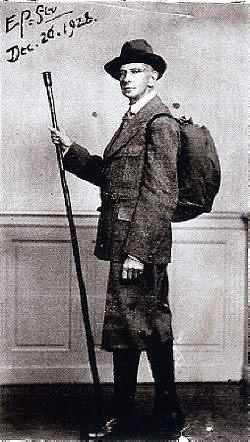

Queer Places:
Madison Masonic Lodge, 170 Main St, Madison, NJ 07940
.jpg) Edward Irenaeus Prime-Stevenson (January 29, 1858, Madison, New Jersey –
July 23, 1942, Lausanne, Switzerland) was an American author. He used the
pseudonym Xavier Mayne.[1]
Edward Prime-Stevenson’s character Dayneford, in ‘Out of the Sun’ (1913), has
a small library in his villa on Capri, its walls ‘tinted in the significant
green’ (green and red at the end of the XIX century were the colors linked to
homosexuals), containing about thirty different homosexual books: the old
(Tibullus, Háfiz, Shakespeare, etc.) and the new (Whitman, Tennyson, Rachilde,
Sturgis, etc.). Prime-Stevenson’s Imre is a love story doubling as a
gay travel guide and handbook. Passion is quite undisguised. An Englishman
called Oswald meets a Hungarian lieutenant called Imre. They battle through
the long process of self-revelation and are last seen blissfully strolling
along the Danube to the nerve-thrilling sounds of a gypsy orchestra.
Edward Irenaeus Prime-Stevenson (January 29, 1858, Madison, New Jersey –
July 23, 1942, Lausanne, Switzerland) was an American author. He used the
pseudonym Xavier Mayne.[1]
Edward Prime-Stevenson’s character Dayneford, in ‘Out of the Sun’ (1913), has
a small library in his villa on Capri, its walls ‘tinted in the significant
green’ (green and red at the end of the XIX century were the colors linked to
homosexuals), containing about thirty different homosexual books: the old
(Tibullus, Háfiz, Shakespeare, etc.) and the new (Whitman, Tennyson, Rachilde,
Sturgis, etc.). Prime-Stevenson’s Imre is a love story doubling as a
gay travel guide and handbook. Passion is quite undisguised. An Englishman
called Oswald meets a Hungarian lieutenant called Imre. They battle through
the long process of self-revelation and are last seen blissfully strolling
along the Danube to the nerve-thrilling sounds of a gypsy orchestra.
Edward Prime Stevenson was born on January 29, 1858, in Madison, New Jersey.[1] His father was a Presbyterian minister and a school principal; his mother was the offspring of a family of men of letters.[1]
After studying law, Stevenson decided to become a writer and a journalist.[1] In 1901 he moved to Europe, living in Florence and Lausanne, where he died of a heart attack in 1942.
In 1896 Stevenson published The Square of Sevens, and the Parallelogram: An Authoritative Method of Cartomancy with a Prefatory Note by Robert Antrobus that was supposedly written in 1735. However, it is believed that he was the author.
In 1906, under the pseudonym Xavier Mayne, Stevenson published the homosexually themed novel Imre: A Memorandum, and in 1908 a sexology study, The Intersexes,[1] a defense of homosexuality from a scientific, legal, historical, and personal perspective.

Edward Prime-Stevenson wrote "Once: But Not Twice" in 1913. This story centers on Bertram Jaques, a middle-aged man who twenty years earlier had been rejected in the throes of a youthful passionate friendship by his friend's marriage. Now, after the wife's death, he writes his friend Douglas Macray offering him the opportunity to resume their friendship with a new union to make up for time lost. Macray decides he will take the chance but dies suddenly of a heart attack on his way to meet his friend at the opera. Stevenson's tale is little known, published as it was in a privately printed collection that was rife with personal allusions. “Her Enemy, Some Friends—and Other Personages: Stories and Studies Mostly of Human Hearts” (1913) is full of Steven-son's own experience, as he himself pointed out in several letters to his friend George Woodberry in the early 1920s. The story's dedicatee is Harry Harkness Flagler, the son of the great oil tycoon, with whom Stevenson was in love in the early 1890s. Young Flagler was known for his wild escapades, but it may have been his lifelong interest in opera that drew him to Stevenson, the music reviewer for The Independent. After a friendship of several years, by 1893 there apparently occurred a falling-out that puzzled Stevenson. Flagler married. A brief reference in a subsequent letter to Woodberry suggests that the two may have later made peace, though Stevenson remained single.
My published books: